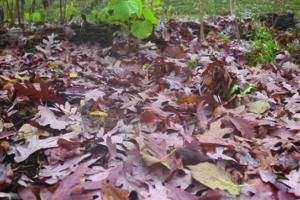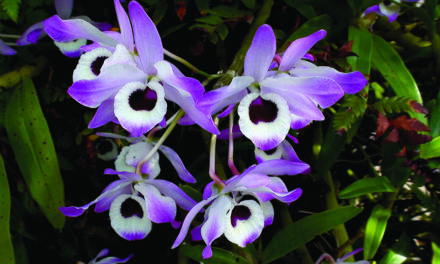
Fallen leaves help maintain the protective layer for hibernating pollinators.
Even when they look dry and “dead,” our green spaces are full of life.
When we think about plants, for example, we can see that herbaceous perennials seem dry but they are actually just retreating underground, while annuals continue their life cycle by spending the winter as seeds in the ground.
The same is true for other organisms that live in our green spaces.
Squirrels become less active, snakes retreat to sheltered spaces and insects may overwinter as adults underground or in crevasses or as juveniles in their nests or chrysalises.
Among these insects, there is a particular group that we seem to take a lot of effort to protect in season, but that we may forget about in the fall and winter — our pollinators.
Where are our pollinators
in the winter?
Pollinators don’t disappear in the winter.
Instead, they either migrate to warmer conditions (like monarchs do; check out maps.journeynorth.org to know where they are now) or they stick around and overwinter right here in protected spaces such as crevasses, underground nests, and within plant stems.
Here are some specific ways that allow us to take care of our green spaces in the fall, all while continuing to support these organisms we worked so hard to support throughout the growing season.
Stems and twigs
Many of our bee pollinators build their nests in the interior of hollow twigs and branches, such as those grown by Black-Eyed Susans, bee balms, sunflowers and asters.
These bees have been actually entering these spaces throughout the season, building nests within them, provisioning them with pollen, and then laying their eggs in them.
During the summer and early fall, these eggs hatched and the larvae started developing — meaning that when everything seems dead to us, these branches are actually acting as tiny bee buildings, hosting the bee larvae that will become the flying bees we will see next spring.
If we want to promote and help these bees in our yards, the best way to continue protecting them in the winter is by not disturbing their nests.
This means that if we see dry stems of these plants standing in our yards, we can either let them be if they aren’t too tall or prune them down to 8-24 inches if they are too tall to leave.
On the latter, consider that the taller the better, especially if we are trimming them down at this time of the year.
If we trim the stems, what we prune out can be piled up in a section of the yard that won’t be disturbed, which will allow the bees that may have been in the cut section of the stem to finish their development somewhere else around our houses.
Along with this, and if we want to proactively provide “organized” nesting for these bees, next spring cut some of the stems in question down to those same heights as soon as the plants are done blooming.
These stems will then act as nesting spaces that will already have the height we want, meaning that there will be no need to trim them down in the fall and risk disturbing some of the nests that they may contain.
Leaves
Many butterflies and moths also survive in the leaf litter, and many bees nest in the ground.
In temperate regions such as Maryland, the leaf litter acts as a protective layer for pollinators, buffering them from extreme temperatures and protecting them from predators.
For this reason, if we want to protect these overwintering pollinators, it is a good idea to leave the leaf litter in our green spaces, letting it remain on the ground.
If we absolutely need to move it away, a good alternative is to leave a part of the area undisturbed, where the litter will continue to protect at least the pollinators that were nesting in that section of the yard.
Although there are other and complementary ways to continue providing nesting resources to pollinators in the winter and throughout the growing season, these two are relatively easy to implement in our area.
If you would like to learn a lot more about these and other techniques, visit the Xerces Society online at xerces.org.
(Editor’s note: Anahí Espíndola, is an assistant professor in the University of Maryland College Park’s Department of Entomology. This article first appeared in the University of Maryland Extenion Master Gardeners’ Maryland Grows Blog.)




